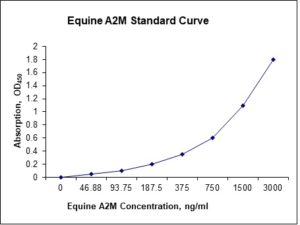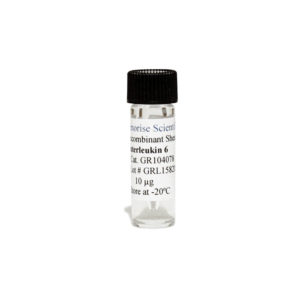Nori Equine A2M ELISA Kit
This ELISA kit is for quantification of A2M in horse. This is a quick ELISA assay that reduces time to 50% compared to the conventional method, and the entire assay only takes 3 hours. This assay employs the quantitative sandwich enzyme immunoassay technique and uses biotin-streptavidin chemistry to improve the performance of the assays. An antibody specific for A2M has been pre-coated onto a microplate. Standards and samples are pipetted into the wells and any A2M present is bound by the immobilized antibody. After washing away any unbound substances, a detection antibody specific for A2M is added to the wells. Following wash to remove any unbound antibody reagent, a detection reagent is added. After intensive wash a substrate solution is added to the wells and color develops in proportion to the amount of A2M bound in the initial step. The color development is stopped, and the intensity of the color is measured.
Alternative names for A2M: alpha-2-Macroglobulin (α2M)
This product is for laboratory research use only not for diagnostic and therapeutic purposes or any other purposes.
- Description
- How Elisa Works
- Product Citation (0)
- Reviews (0)
Description
Nori Equine A2M ELISA Kit Summary
Alternative names for A2M: alpha-2-Macroglobulin (α2M)
Alternative name for equine: Horse
| Assay Type | Solid Phase Sandwich ELISA |
| Format | 96-well Microplate or 96-Well Strip Microplate |
| Method of Detection | Colorimetric |
| Number of Targets Detected | 1 |
| Target Antigen Accession Number | F6R942 |
| Assay Length | 3 hours |
| Quantitative/Semiquantitative | Quantitative |
| Sample Type | Plasma, Serum, Cell Culture, Urine, Cell/Tissue Lysates, Synovial Fluid, BAL, |
| Recommended Sample Dilution (Plasma/Serum) | No dilution for sample <ULOQ; sufficient dilution for samples >ULOQ |
| Sensitivity | 9 ng/mL |
| Detection Range | 46.88-3000 ng/mL |
| Specificity | Equine A2M |
| Cross-Reactivity | < 0.5% cross-reactivity observed with available related molecules, < 50% cross-species reactivity observed with species tested. |
| Interference | No significant interference observed with available related molecules |
| Storage/Stability | 4 ºC for up to 6 months |
| Usage | For Laboratory Research Use Only. Not for diagnostic or therapeutic use. |
| Additional Notes | The kit allows for use in multiple experiments. |
Standard Curve
Kit Components
1. Pre-coated 96-well Microplate
2. Biotinylated Detection Antibody
3. Streptavidin-HRP Conjugate
4. Lyophilized Standards
5. TMB One-Step Substrate
6. Stop Solution
7. 20 x PBS
8. Assay Buffer
Other Materials Required but not Provided:
1. Microplate Reader capable of measuring absorption at 450 nm
2. Log-log graph paper or computer and software for ELISA data analysis
3. Precision pipettes (1-1000 µl)
4. Multi-channel pipettes (300 µl)
5. Distilled or deionized water
Protocol Outline
1. Prepare all reagents, samples and standards as instructed in the datasheet.
2. Add 100 µl of Standard or samples to each well and incubate 1 h at RT.
3. Add 100 µl of Working Detection Antibody to each well and incubate 1 h at RT.
4. Add 100 µl of Working Streptavidin-HRP to each well and incubate 20 min at RT.
5. Add 100 µl of Substrate to each well and incubate 5-30 min at RT.
6. Add 50 µl of Stop Solution to each well and read at 450 nm immediately.
Background:
alpha-2-Macroglobulin (α2M) is a large (720 KDa) plasma protein found in the blood. It is mainly produced by the liver, and also locally synthesized by macrophages, fibroblasts, and adrenocortical cells. It is encoded by the A2M gene. Alpha 2 macroglobulin acts as an antiprotease and is able to inactivate an enormous variety of proteinases. It functions as an inhibitor of fibrinolysis by inhibiting plasmin and kallikrein and as an inhibitor of coagulation by inhibiting thrombin. Alpha-2-macroglobulin may act as a carrier protein because it also binds to numerous growth factors and cytokines, such as platelet-derived growth factor, basic fibroblast growth factor, TGF-β, insulin, and IL-1β. No specific deficiency with associated disease has been recognized, and no disease state is attributed to low concentrations of alpha-2-macroglobulin. It functions as an inhibitor of coagulation by inhibiting thrombin.[1] Receptor binding domain exposure allows the aM protease complex to bind to clearance receptors and be removed from circulation.[2] Tetrameric, dimeric, and, more recently, monomeric aM protease inhibitors have been identified.[3] Alpha-2 macroglobulin is genetically associated with Alzheimer disease.[4] Serum alpha 2-macroglobulin and alpha 1-inhibitor 3 concentrations are increased in hypoalbuminemia by post-transcriptional mechanisms.[5] The concentration of alpha-2-macroglobulin rises 10-fold or more in the nephrotic syndrome when other lower molecular weight proteins are lost in the urine. The loss of alpha-2-macroglobulin into urine is prevented by its large size. The net result is that alpha-2-macroglobulin reaches serum levels equal to or greater than those of albumin in the nephrotic syndrome, which has the effect of maintaining oncotic pressure.
References
- de Boer JP, et al. (1993). Infect. Immun. 61 (12): 5035–43.
- Van Leuven F, et al. (1986). J. Biol. Chem. 261 (35): 16622–5.
- Dodds AW, Law SK (1998). Immunol. Rev. 166: 15–26.
- Blacker D, et al. (1998). Nat. Genet. 19 (4): 357–60.
- Stevenson, FT, et al. (1998) Kidney International. 53 (1): 67–75.
Be the first to review “Nori Equine A2M ELISA Kit”
You must be logged in to post a review.






























Reviews
There are no reviews yet.